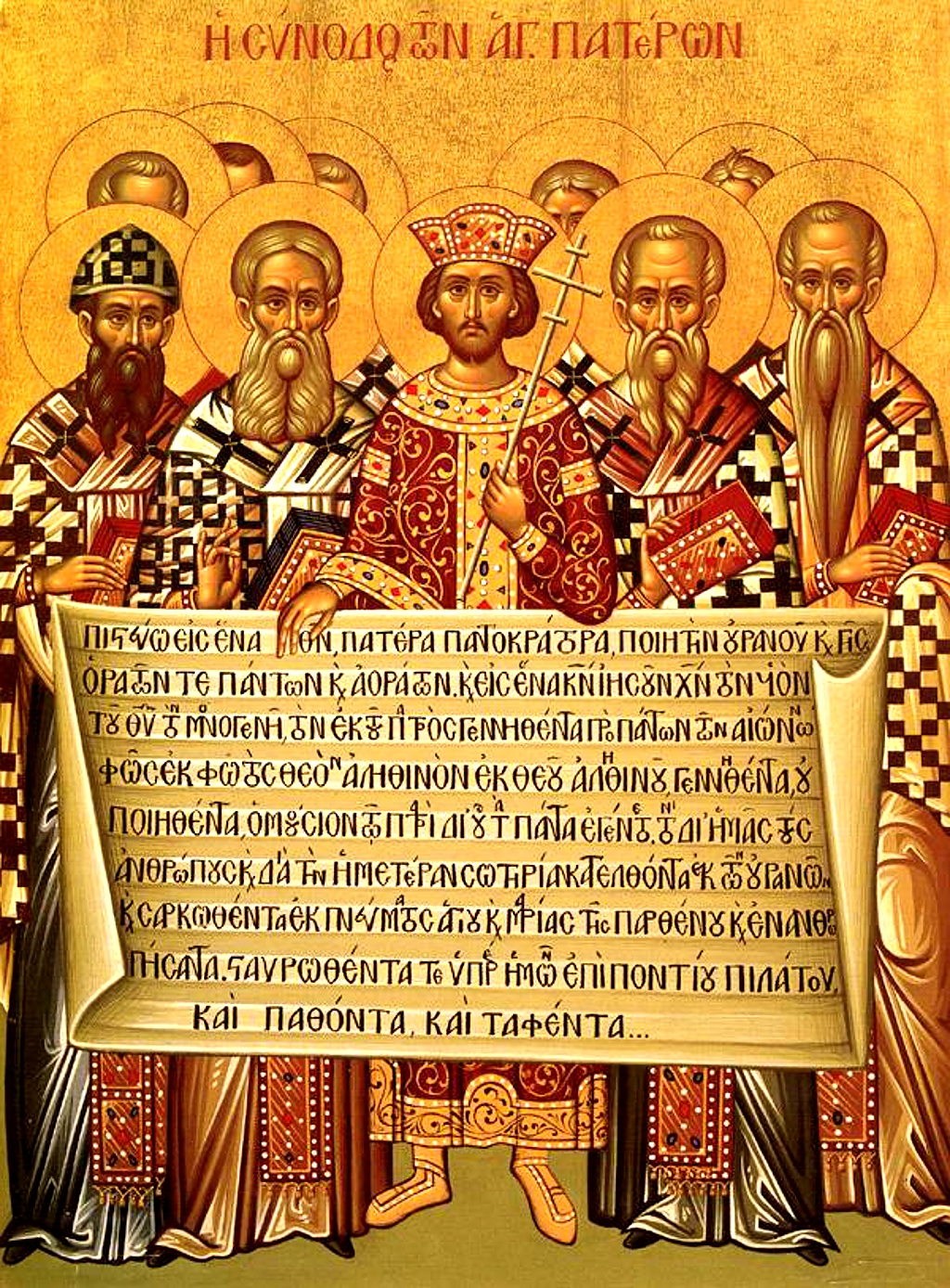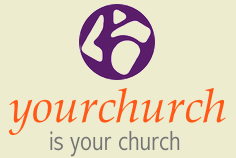
holding the Nicene-Constantinopolitan Creed of 381
Emperor Constantine (center) and the bishops
❖ Video
❖ Audio (Message)
Creeds
(NICENE Creed, Apostles’ Creed)
Andy Nagahara
Today I’m going to take a break from my usual Proverbs series and talk about creed. In Japanese, the word “creed” is pronounced “shinjou”.
If you ask Japanese people, many of them will think of Shinjo-san of the Nippon Ham Fighters, but I’m not going to talk about him today. (Sorry, this is just a Japanese wordplay joke.)
The word “shinjo” which means “creed” is generally used to mean something that one firmly believes in based on one’s own values.
In Christian churches, it is a statement that summarizes the content of faith in the form of a confession, and is used by most denominations.
It is this “creed” that I would like to talk about today. I will talk about two of these creeds, the Apostles’ Creed and the Nicene Creed.
1. What is a Creed?
Creeds, which emerged throughout the history of Christianity, are statements that clearly and concisely express the content of our faith.
Some people may think that having a Bible is enough, but there is no one who can read the Bible on their own and accurately understand the contents of faith from it. This is because the Bible is not a systematic statement of the content of faith.
Historically, creeds have been necessary for two reasons. First, Christianity, which had long been persecuted in the Roman Empire, became an official religion, and the number of people who believed and were baptized increased dramatically. Therefore, it was necessary to ensure that those seeking baptism correctly understood the content of the faith and were able to express it concisely. In response to this demand, a creed called the Old Roman Creed was made in the 2nd or 3rd century and that was the prototype of the current Apostles’ Creed.
Another need was to settle disputes about the core content of the faith. In fact, from the very beginning of the Christian church, differences in how to interpret Biblical expressions have led to groups being rejected as heretics and major divisions occurring. In order to organize what we believe and settle the controversial aspects of our faith, the leaders of the time, known as church fathers, gathered together to discuss and express the faith as the thinking of the entire Christian church.
2. Two Representative Creeds
The Apostles’ Creed is the one most commonly used in churches today. There are many churches where everyone confesses out loud during the worship service. It is used in Protestant and Catholic churches known as the Western Church. It is not used in Eastern churches such as the Russian Orthodox Church or the Greek Orthodox Church.
As mentioned earlier, the Apostles’ Creed was based on the Old Roman Creed, which was refined and took on its current form around the 4th century, and it became known as the Apostles’ Creed, but it is not known when and where it was established.
Now let us read the Apostles’ Creed.
Apostles’ Creed
I believe in God, the Father almighty,
creator of heaven and earth.
I believe in Jesus Christ, God’s only Son, our Lord,
who was conceived by the Holy Spirit,
born of the Virgin Mary,
suffered under Pontius Pilate,
was crucified, died, and was buried;
he descended to the dead.
On the third day he rose again;
he ascended into heaven,
he is seated at the right hand of the Father,
and he will come to judge the living and the dead.
I believe in the Holy Spirit,
the holy catholic Church,
the communion of saints,
the forgiveness of sins,
the resurrection of the body,
and the life everlasting. Amen.
(English Language Liturgical Consultation 1988)
Another representative creed is the Nicene Creed, established in 381. More precisely, it is called the Nicene-Constantinopolitan Creed. This is because the original “Nicene Creed” was established at the Church Council held in Nicaea in 325.
Nicaea is located about 100 km southeast of Istanbul in a place now called Iznik. The Council of Nicaea was the first major meeting in the history of the Christian church to bring together leaders from all over the church. It was opened because it was judged that a great crisis had come upon the Christian faith. The crisis was the beginning of the spread of the idea within the church that Jesus was not God but a created being, a human being. At this council the Church issued a creed proclaiming that Jesus is the same God as the Father.
However, not only did the forces that believed that Jesus was different from God continue to support the Church, but other groups also emerged, including those that believed that Jesus was roughly the same as God, but not completely, and those that believed that Jesus was a human being but more similar to God than anyone else.The confusion continued, and after half a century had passed, another church council was convened in Constantinople. Constantinople is now Istanbul. However, since what it established reaffirmed and strengthened the Nicene Creed, it came to be known as the Nicene-Constantinopolitan Creed. This is the Nicene Creed that appears in our weekly bulletin.
The greatest contribution of the Nicene Creed was not only to establish that Jesus is one with the Father, but also to clarify the Trinity of Father, Son and Holy Spirit, including the Holy Spirit. Since then, it has continued to be used as a major creed in both the Eastern and Western Churches.
The universal and fundamental doctrine of Christianity that we believe in, the Trinity (“there is one God, who manifests himself as Father/Creator, Son/Savior, and Holy Spirit/Helper”), was finalized in the Nicene Creed in 381.
So let’s read the Nicene Creed.
NICENE Creed
We believe in one God, the Father almighty, maker of heaven and earth, of all things visible and invisible.
And in one Lord Jesus Christ, the only Son of God, begotten from the Father before all ages, God from God, Light from Light, true God from true God, begotten, not made; of the same essence as the Father. Through him all things were made. For us and for our salvation he came down from
heaven; he became incarnate by the Holy Spirit and the virgin Mary, and was made human. He was crucified for us under Pontius Pilate; he suffered and was buried. The third day he rose again, according to the Scriptures. He ascended to heaven and is seated at the right hand of the Father. He will come again with glory to judge the living and the dead. His kingdom will never end.
And we believe in the Holy Spirit, the Lord, the giver of life. He proceeds from the Father and the Son, and with the Father and the Son is worshiped and glorified. He spoke through the prophets.
We believe in one holy catholic and apostolic church. We affirm one baptism for the forgiveness of sins. We look forward to the resurrection of the dead, and to life in the world to come. Amen.
3. Why Nicea?
Now, on the back of Your Church’s weekly bulletin is not the Apostles’ Creed but the Nicene Creed. The Apostles’ Creed is by far the most widely used in Protestant churches. We are not rejecting the Apostles’ Creed. Furthermore, there is no superiority or inferiority between the Nicene Creed and the Apostles’ Creed. There was a time when the Apostles’ Creed was appeared in our bulletin.
In terms of simplicity, the Apostles’ Creed is better. On the other hand, Nicene is more precise in its expression of the relationship between the Father, the Son, and the Holy Spirit.
I wanted to introduce the Nicene Creed to you because I thought it would be beneficial for you to deepen your relationship with Jesus. It gives us a more detailed description of who Jesus is. In many Protestant churches, we usually pray to the Father “in the name of Jesus,” but we can also pray to Jesus and, of course, to the Holy Spirit. Although we do not confess a creed in worship service, what is written is the foundation of our faith.
I hope you to savor that creed from time to time, and if possible, read it out loud.
You will be able to see that your faith is not vague, but has concrete meaning.
(Prayer) God, we thank you for giving the church a creed so that we can correctly understand and follow your will.
The guidelines you have given us in the form of a Creed allow the Church to walk with you now without straying from your teachings.
Please guide us so that we may continue to follow you without going wrong.
We thank you for your teaching and guidance, and pray in the name of our Lord Jesus Christ.
Summary
The Apostles’ Creed and the Nicene Creed were established in the first five centuries of Christian history and are still used today by Christian Churches as guidelines for our faith. Creeds clearly express the content of our faith, teach us what we should believe, and protect the church from straying from the path of following Jesus.
These creeds are not just precious faith documents from the past that should be kept, but still serve as important guidebooks to guide our journey of faith.
For Discussion
1. Why was the creed established?
2. Share your findings after comparing the Apostles’ Creed and the Nicene Creed.
